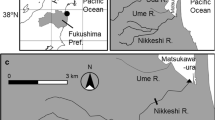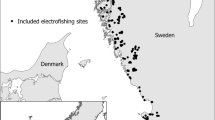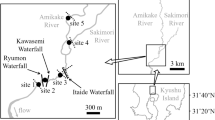Abstract
Catches of Japanese eels have been decreasing at an alarming rate and extinction of wild stocks is of concern. Therefore, conservation of eel habitats has become increasingly important. Here, we analyzed the habitat preferences of Japanese eels using generalized linear models from the relationships between presence/absence or population density with physical environmental factors. The models suggested the characteristics of preferred habitats that should be conserved. In the tidal reaches, the densities of small eels (< 255 mm total length) at the reach scale (generally channel width × 101 in flow direction) were only correlated with riverbed gradient, with densities decreasing with increasing gradients. Within the low-gradient reaches, small eels appeared at shallow depths (about 15–30 cm) and slow-flow runs at the channel-unit scale (generally channel width × 100 in flow direction) and their preferred substrate type was gravel (< 100 mm). The densities of large eels (≥ 255 mm total length) at the reach scale were only correlated with the percentage of concrete revetment along shoreline, with their densities decreasing with increasing revetment shoreline. At the channel-unit scale, the densities of large eels were correlated only by predominant substrate type, and they appeared to prefer rock (≥ 100 mm). Few small eels were found in the non-tidal reaches; therefore, their habitat preferences were not analyzed there. By contrast, large eels were frequently distributed at the lower riverbed gradient reaches. At the channel-unit scale, the densities of large eels increased with water depth and their preferred substrate type was rock. These habitat preferences suggest diversification of habitat with growth and difference in the preferred substrate type depending on body size at the channel-unit scale. These results indicated that various environments in rivers should be preserved. In addition, we suggest the necessity to restore habitats affected by revetment. Eel habitat preferences, especially in the non-tidal reaches, also will contribute to determining what kind of cross-river structures affect eel distribution in rivers.




Similar content being viewed by others
Change history
26 September 2019
In the original publication, in Results section, the sentence starting with “Three silver eels….” has been incorrectly published with the word “Query” in between the text. The corrected sentence should read as:
References
Akobeng AK (2007) Understanding diagnostic test 3: receiver operating characteristic curves. Acta Paediatrica 96:644–647
Aoyama J, Sasai S, Miller MJ, Shinoda A, Nakamura A, Kawazu K, Tsukamoto K (2002) A preliminary study of the movements of yellow and silver eels, Anguilla japonica, in the estuary of the Fukui River, Japan, as revealed by acoustic tracking. Hydrobiologia 470:31–36
Aoyama J, Shinoda A, Sasai S, Miller MJ, Tsukamoto K (2005) First observations of the burrow of Anguilla japonica. J Fish Biol 67:1534–1543
Asakura T, Kumagi S, Goto H, Akagawa I (2011) Pipe choice by yellow eel stage of Anguilla japonica collected in the lower reaches of small rivers in Shizuoka Prefecture, Japan. J Sch Mar Sci Tech, Tokai Univ 9:35–41
Bisson PA, Buffington JM, Montgomery DR (2017) Valley segments, stream reaches, and channel units. In: Hauer FR, Lamberti GA (eds) Methods in stream ecology, Third edition, 1. Acad Press, Cambridge, pp 23–49
Burnham KP, Anderson DR (2002) Model selection and multimodel inference: a practical information-theoretic approach. Springer, New York
Chow S, Kurogi H, Mochioka N, Kaji S, Okazaki M, Tsukamoto K (2008) Discovery of mature freshwater eels in the open ocean. Fish Sci 75:257–259
Domingos I, Costa JL, Costa MJ (2006) Factors determining length distribution and abundance of the European eel, Anguilla anguilla, in the River Mondego (Portugal). Freshw Biol 51:2265–2281
East Asia Eel Resource Consortium (2012) Statement of the East Asia Eel Resource Consortium for the protection and conservation of the Japanese eel. http://easec.info/download/120319_declarations_en.pdf#search=%27East+asia+eel+resource+consortium%27. Accessed on 9 April 2018
Feunteun E (2002) Management and restoration of European eel population (Anguilla anguilla): An impossible bargain. Ecol Eng 18:575–591
Fisheries Agency of Japan (2018) Unagi wo meguru joukyo to taisaku ni tsuite (The condition and managements of eel resource). http://www.jfa.maff.go.jp/j/saibai/attach/pdf/unagi-92.pdf. Accessed at November 19, 2018
Fukuda N, Miller MJ, Aoyama J, Shinoda A, Tsukamoto K (2013) Evaluation of the pigmentation stage and body proportions from the glass eel to yellow eel in Anguilla japonica. Fish Sci 79:425–438
Geospatial Information Authority of Japan. GSI Maps. https://maps.gsi.go.jp/#5/36.104611/140.084556/&base=std&ls=std&disp=1&vs=c1j0h0k0l0u0t0z0r0s0f1. Accessed on 13 December 2017
Glova GJ, Jellyman DJ, Bonnett ML (1998) Factors associated with the distribution and habitat of eels (Anguilla spp.) in three New Zealand lowland streams. NZ J Mar Freshw Res 32:255–269
Glova GJ (2001) Effects of the presence of subadult longfinned eels (Anguilla dieffenbachii) on cover preferences of juvenile eels (Anguilla spp.) in replicate channels. NZ J Mar Freshw Res 35:221–233
Glova GJ, Jellyman DJ, Bonnett ML (2001) Spatiotemporal variation in the distribution of eel (Anguilla spp.) populations in three New Zealand lowland streams. Ecol Freshw Fish 10:147–153
Harada M, Kume M, Mochioka N, Tamura Y, Kanzaki T, Hashiguchi S, Kasai A, Yamashita Y (2018) Japanese eel Anguilla japonica and aquatic animals collected with Ishi-kura net in the Iroha and Katsura Rivers, Oita Prefecture, Japan. Nippon Suisann Gakkaishi 84:45–53
Ichiyanagi H, Watanabe K, Mori S (2012) Habitats and population dynamics of the bagrid catfish Pseudobagrus ichikawai: as the basic knowledge for conservation. Ecol Civil Eng 15:257–267
Imbert H, Labonne J, Rigaud C, Lambert P (2010) Resident and migratory tactics in freshwater European eels are size-dependent. Freshw Biol 55:1483–1493
Inui R, Hitotsumatsu A, Akamatsu Y, Kono T (2016) Development of model prediction for fish biomass in Saba River, Japan. Doboku Gakkai Ronbunsyu B1 (suikougaku) 72:I_997–I_1002
Ishiyama N, Watanabe K, Nagayama S, Nakamura F, Kenmotsu H, Takahashi H, Maruoka N, Iwase H (2009) The influence of bedrock outcrop on stream fish habitat, and the assessment of restoration in a bedrock stream channel. Ecol Civil Eng 12:57–66
Ishiyama N, Nagayama S, Akasaka T, Nakamura F (2012) Habitat use by endangered Japanese crayfish (Cambaroides japonicus) in low-gradient streams of southern Hokkaido, Japan: reach and microhabitat-scale analysis. Hydrobiologia 686:257–266
Itakura H, Kitagawa T, Miller MJ, Kimura S (2015a) Declines in catches of Japanese eels in rivers and lakes across Japan: Have river and lake modifications reduced fishery catches? Landsc 11:147–160
Itakura H, Kaino T, Miyake Y, Kitagawa T, Kimura S (2015b) Feeding, condition, and abundance of Japanese eels from natural and revetment habitats in the Tone River, Japan. Envir Biol Fish 98:1871–1888
Itakura H, Miyake Y, Kitagawa T, Kimura S (2018) Site fidelity, diel and seasonal activities of yellow-phase Japanese eels (Anguilla japonica) in a freshwater habitat as inferred from acoustic telemetry. Ecol Freshw Fish 2018; 27 737–751. https://doi.org/10.1111/eff.12389
Iwasaki A, Yoshimura C (2012) Effect of river fragmentation by crossing structures on probability of occurrence of freshwater fishes. Doboku Gakkai Ronbunsyu B1 (suikougaku) 68:I_685–I_690
Jacoby D, Gollock M (2014) The IUCN Red List of Threatened Species, Version 2014.3
Jellyman DJ, Sykes JRE (2003) Diel and seasonal movements of radio-tagged freshwater eels, Anguilla spp., in two New Zealand streams. Envir Biol Fish 66:143–154
Jowett IG, Richardson J (1995) Habitat preferences of common, riverine New Zealand native fishes and implications for flow management. NZ J Mar Freshw Res 29:13–23
Kaifu K, Tamura M, Aoyama J, Tsukamoto K (2010) Dispersal of yellow phase Japanese eels Anguilla japonica after recruitment in the Kojima Bay-Asahi River systems, Japan. Envir Biol Fish 88:273–282
Kaifu K, Fisheries Agency, Wildlife Division, Nature conservation bureau, Ministry of Environment, Noritaka Mochioka, Palsystem Consumers’ Co-operative Union, Miki Yamaoka, Hiroyuki Kurota, Takehito Yoshida (2018) Current activities and challenges for conservation and sustainable harvest of Japanese eel in Japan. Nihon Seitai Gakkaishi 68:43-57
Kotake A, Arai T, Okamura A, Yamada Y, Udoh T, Oka HP, Miller MJ, Tsukamoto K (2007) Ecological aspects of the Japanese eel, Anguilla japonica, collected from coastal area of Japan. Zool Sci 24:1213–1221
Koyama A, Inui R, Iyoka H, Akamatsu Y, Onikura N (2016) Habitat suitability of eight threatened gobies inhabiting tidal flats in temperate estuaries: model developments in the estuary of the Kuma River in Kyushu Island, Japan. Ichthyol Res 63:307–314
Kurogi H, Okazaki M, Mochioka N, Jonbo T, Hashimoto H, Takahashi M, Tawa A, Aoyama J, Shinoda A, Tsukamoto K, Tanaka H, Gen K, Kazeto Y, Chow S (2011) First capture of post-spawning female of the Japanese eel Anguilla japonica at the southern West Mariana Ridge. Fish Sci 77:199–205
Matsui I (1972) Unagi gaku (An eel science). Kouseisya-Kouseikaku, Tokyo
The Ministry of the Environment of Japan (2014) Red data book 2014. Gyousei, Tokyo
The Ministry of the Environment of Japan (2015) Heisei 26 nendo Nihonunagi hozen housaku kento itaku gyoumu houkokusyo (Report on entrusted work to consider methods for conservation of Japanese eel in 2014). The Ministry of the Environment of Japan, Tokyo
The Ministry of the Environment of Japan (2016) Heisei 27 nendo Nihonunagi hozen housaku kento itaku gyoumu houkokusyo (Report on entrusted work to consider methods for conservation of Japanese eel in 2015). The Ministry of the Environment of Japan, Tokyo
The Ministry of the Environment of Japan (2017) Nihonunagi seisokuchi hozen notameno kangaekata (Concept of conservation of Japanese eels’ habitats). The Ministry of the Environment of Japan, Tokyo
Nishi G, Imai S (1969) On the juvenile of Anguilla marmorata Quoy et Gaimard in Yakushima (Yaku Island). Its ecology and Morphorogy. Mem Fac Fish, Kagoshima Univ 18:65–76
Nagayama S, Harada M, Kayaba Y (2015) Classification of morphology and habitat in streams and rivers: application to river management. Ecol Civil Eng 18:19–33
Okamura A, Yamada Y, Yokouchi K, Horie N, Mikawa N, Utoh T, Tanaka S, Tsukamoto K (2007) A silvering index for the Japanese eel Anguilla japonica. Envir Biol Fish 80:77–89
Onikura N, Nakajima J, Miyake T, Kawamura K, Fukuda S (2012) Predicting distributions of seven bitterling fishes in northern Kyushu, Japan. Ichthyol Res 59:124–133
Onikura N, Inui R, Oikawa S, Kawamoto T (2014) Performance of a species distribution model based on presence/absence for various population sizes in the amphidromous fish species Sicyopterus japonicus. Ichthyol Res 61:90–96
Shiao JC, Iizuka Y, Chang CW, Tzeng WN (2003) Disparities in habitat use and migratory behavior between tropical eel Anguilla marmorata and temperate eel A. japonica in four Taiwanese rivers. Mar Ecol Prog Ser 261:233–242
R Core Team (2016) R: a language and environment for statistical computing. R foundation for Statistical Computing, Vienna. https://www.r-project.org
Solomon DJ, Beach MH (2004) Fish pass design for eel and elver (Anguilla anguilla). R&D Technical Report W2-070/TR1. Environment Agency of UK, Bristol
Suzuki O (1998) Relationship between standard length and preferred water velocity on freshwater fish for naturally diverse river construction methods. Doboku Gakkai Ronbunsyu 593:21–29
Tashiro T, Okuda C, Tsujimoto T (2014) Impacts of riverbed armoring below dam and their mitigation due to gravel addition on habitat of benthic fish community. Doboku Gakkai Ronbunsyu B1 (suikougaku) 70:I_1321–I_1326
Tesch FW (2003) The eel, third edition. Blackwell Science Ltd, Oxford
Thibault I, Dodson JJ, Caron F (2007) Yellow-stage American eel movements determined by microtagging and acoustic telemetry in the St Jean River watershed, Gaspé, Quebec, Canada. J Fish Biol 71:1095–1112
Tomie JPN, Cairns DK, Hobbs RS, Desjardins M, Fletcher GL, Courtenay SC (2017) American eel (Anguilla rostrate) substrate selection for daytime refuge and winter thermal sanctuary. Mar Freshw Res 68:95–105
Tsukamoto K, Arai T (2001) Facultative catadromy of the eel Anguilla japonica between freshwater and seawater habitats. Mar Ecol Prog Ser 220:265–276
Tsukamoto K, Aoyama J, Miller MJ (2009) Present status of the Japanese eel: resources and recent research. AFS Symp 58:21–35
Tsukamoto K, Chow S, Otake T, Kurogi H, Mochioka N, Miller MJ, Aoyama J, Kimura S, Watanabe S, Yoshinaga T, Shinoda A, Kuroki M, Oya M, Watanabe T, Hata K, Ijiri S, Kazeto Y, Nomura K, Tanaka H (2011) Oceanic spawning ecology of freshwater eels in the western North Pacific. Nat comm 2:179. https://doi.org/10.1038/ncomms1174
Watanabe K, Ito S (1999) Population size and distribution of Pseudobagrus ichikawai, an endangered bagrid catfish, in the Kawaura River. Japan. J Ichthyol 46:15–30
Watanabe K, Nakamura F, Kamura K, Yamada H, Watanabe Y, Tsuchiya S (2001) Influence of stream alteration on the abundance and distribution of benthic fish. Ecol Civil Eng 4:133–146
White EM, Knights B (1997) Dynamics of upstream migration of the European eel, Anguilla anguilla (L.), in the River Severn and Avon, England, with special reference to the effects of man-made barriers. Fish Manag Ecol 4:311–324
Yamazaki Y, Haramoto S, Fukasawa T (2006) Habitat uses of freshwater fishes on the scale of reach system provided in small streams. Envir Biol Fish 75:333–341
Yokouchi K, Aoyama J, Oka HP, Tsukamoto K (2008) Variation in the demographic characteristics of yellow-phase Japanese eels in different habitats of the Hamana Lake system, Japan. Ecol Freshw Fish 17:639–652
Acknowledgments
We thank R. Oishi, K. Sakai, Y. Hibino, K. Matsukawa, M. Kawazu, R. Tsurukawa, and S. Koseki for cooperation in field survey; Y. Hibino and C. A. Hewavitharane for reading early version of manuscript; all members of fisheries biology laboratory of Kyushu University for discussion. We are grateful to the two anonymous reviewers for their useful advises. Information about cultured eels released into Kedo River system was provided by T. Hirae of the Kagoshima Prefectural Fisheries Technology and Development Center. Editing services were provided by Sea Pen Scientific Writing, LLC. This study was partly supported by eel resource management promotion project of Kagoshima Prefecture.
Author information
Authors and Affiliations
Corresponding author
Additional information
Publisher's Note
Springer Nature remains neutral with regard to jurisdictional claims in published maps and institutional affiliations.
About this article
Cite this article
Matsushige, K., Yasutake, Y. & Mochioka, N. Spatial distribution and habitat preferences of the Japanese eel, Anguilla japonica, at the reach and channel-unit scales in four rivers of Kagoshima Prefecture, Japan. Ichthyol Res 67, 68–80 (2020). https://doi.org/10.1007/s10228-019-00704-x
Received:
Revised:
Accepted:
Published:
Issue Date:
DOI: https://doi.org/10.1007/s10228-019-00704-x




